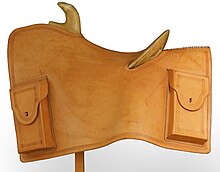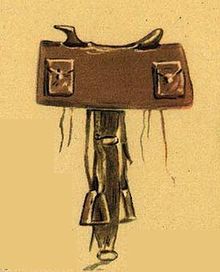Pony Express mochila





A mochila (Spanish,[1] pronounced [mo-chee-lah], for "knapsack", "pack", "pouch") is a removable lightweight leather cover put over a horse's saddle. In the nineteenth century, it was used as a mail bag by the Pony Express. The eighth-of-an-inch leather cover draped over the saddle on a horse. There were slits cut into the leather which allowed the saddle horn and cantle to protrude through.[2]
Riders of the Pony Express made quick exchanges to new fresh horses, usually within a few minutes at each remount station on their route across the United States. The mochila was removed from the exhausted horse and swiftly placed over the saddle of the new fresh waiting horse that the relay station had for him.[3]
Etymology
Joan Corominas[4] derives the Spanish mochila from mochil ("delivery boy"), itself from Basque mutil ("boy").
History and usage
The word "mochila" connotes the soft sheepskin leather.[A]
Saddle bag mail pouches were never in use on the Pony Express system because of their unwieldiness. The normal large saddle bags were not adept to attaching to a saddle efficiently and would cause much delay when going from an exhausted horse to a fresh horse when the Pony Express rider switched horses at a station.[5] In 1860 the Pony Express developed a fast mail delivery system using a special saddle mail bag cover called a mochila that made the Pony Express unique. The cover, which had 4 hard leather boxes to carry the mail, was quick and efficient when transferring from one horse to another. All the rider had to do was change this leather cover with the mail boxes over to a ready horse waiting for him at the station, which was usually done in under 2 minutes. If a horse was injured on the way from one station to another and not capable of further traveling, then all a rider had to do was to take the cover with its mail off the injured horse and walk to the next station to get a new horse. He then threw the cover onto the new saddled horse. The leather blanket cover was designed by Jay G. Kelley, another Pony Express rider. The saddles for the horses that traveled over the Overland Pony Express route were special and standardized, built by a saddlery firm owned and franchised by Israel Landis and sons.[2][6][7][8]
Pony Express riders traveled about 100 miles at any one time. In this travel they would change horses every dozen or so miles. When he changed horses to a fresh new horse the rider would grab the mochila off the saddle of the exhausted horse and throw it over the saddle of the new horse at a remount station. This mochila saddle blanket cover the rider would then sit on. It had sewn to it certain pockets that were always locked. Only authorized people could unlock these attached pockets to retrieve the mail. This mail service was very expensive (e.g., 1-5 dollars per half ounce, an astronomical amount that only businesses could afford).[3]
Pony Express adopted this mochila (a type of mailbag with 4 pockets to secure letters and mail) for their fast mail service. The saddles and mochilas were standardised and made the same so they would work from one horse to another. When full of mail and telegrams it weighed about 20 pounds.[2] The rider would carry additionally a canteen of water, a gun, and a small bible which included the solemn loyalty oath he had to take as a precondition to becoming a rider.[9][10] If a horse became injured beyond use or was killed, the rider would strip the mochila with its mail from the saddle and walk to the next relay transfer station.[5]
The mochila’s mail pockets were called "cantinas", which were locked with a type of small padlock. Two cantinas were in front of the rider’s legs and two were behind the rider’s thighs. The letters were first covered with oiled silk so they wouldn’t be damaged by water or sweat and then placed into the "cantinas", which were then locked.[6] Most Pony Express saddles and mochilas were made by Israel Landis’ shop in St. Joseph, Missouri.[11] Israel made the entire saddle about one-third the weight of the ordinary Western saddle.[5] The specially designed saddle with its mochila weighed less than 13 pounds.[5]
No actual used Pony Express mochilas have survived. Replicas have been made for demonstrations like Buffalo Bill’s Wild West performances and modern day reenactments.[12]
See also
Bibliography
Footnotes
- ^ The word "mochila" is derived from the Arabic and is related to the word "mocha", a fine-quality coffee, and a drink or flavoring made with it "typically with chocolate added." Specifically, it refers to "a soft leather made from sheepskin" and stems from Mocha, the Red Sea port, from which "the coffee and leather were first shipped." Oxford English Dictionary.
References
- ^ mochila, Diccionario de la Real Academia Española, 22ª edición.
- ^ a b c Tucker, p. 18
- ^ a b Pope, Nancy. "Pony Express Mochila". Former Object of the Month. National Postal Museum, Smithsonian Institution. Retrieved August 17, 2012.
- ^ mochila in Diccionario crítico etimológico castellano e hispánico, volume IV, page 94, Joan Corominas, José A. Pascual, Editorial Gredos, 1989 ISBN 84-249-0066-9
- ^ a b c d "The Mochila". Pony Express History. Retrieved August 16, 2012.
- ^ a b Van der Linde, p. 23
- ^ Israel Landis
- ^ Pony Express saddle
- ^ KidCaps 2012, p. 21.
- ^ Marlow 2013, p. 94.
- ^ Ridge, Martin (Autumn 1996). "Reflections on the Pony Express". Montana: The Magazine of Western History. 46 (3). Montana Historical Society: 2–13.
- ^ "The Horse". Canadian Museum of Civilization. May 28, 2010. Retrieved August 17, 2012.
Sources
- KidCaps (2012). The Pony Express: A History Just for Kids!. BookCaps Study Guides. ISBN 978-1-62107-450-2.
{{cite book}}: Invalid|ref=harv(help) - Van der Linde, Laurel (1993). The Pony Express. New York: New Discovery Books. ISBN 0027590569.
- Marlow, Susan (2013). Canyon of Danger. Kregel Publications. ISBN 978-0-8254-7980-9.
{{cite book}}: Invalid|ref=harv(help) - Tucker, Mary (2012). Pony Express. Lorenz Educational Press. ISBN 0787786063.
{{cite book}}:|format=requires|url=(help)
Further reading
- Cushing, Marshall (1893). The Story of Our Post Office: The Greatest Government Department in all its Phases. Boston, Massachusetts: A.M. Thayer & Co. at Internet archive
- Melius, Louis (1917). The American postal service: history of the postal service from the earliest times. The American system described with full details of operation. Washington, D.C.: National Capital Press. Retrieved August 15, 2012. at Internet Archive
